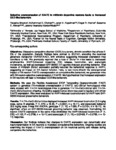Selective Overexpression of EAAT3 in Midbrain Dopamine Neurons Leads to Increased OCD-like Behaviors.
| dc.contributor.author | Greene, N | |
| dc.contributor.author | Chohan, M | |
| dc.contributor.author | Kopelman, J | |
| dc.contributor.author | Kramer, Edgar | |
| dc.contributor.author | Ahmari, S | |
| dc.contributor.author | Veenstra-VanderWeele, J | |
| dc.date.accessioned | 2021-08-16T10:30:09Z | |
| dc.date.available | 2021-08-16T10:30:09Z | |
| dc.date.issued | 2020-10 | |
| dc.identifier.uri | http://hdl.handle.net/10026.1/17594 | |
| dc.description.abstract |
Objectives. Obsessive compulsive disorder (OCD) is a severe, chronic condition that affects 2- 3% of the population. Genetic findings have pointed to SLC1A1, encoding the neuronal glutamate transporter EAAT3/EAAC1, with evidence suggesting increased expression may contribute to risk. We previously reported that a loss of Slc1a1 in mice leads to decreased amphetamine (AMPH)-induced dopamine (DA) release, locomotion, and stereotypic movements, as well as decreased SKF-38393 (D1-agonist)-induced grooming behavior. Viral rescue of midbrain Slc1a1 expression partially restored the behavioral response to AMPH, suggesting an impact on DA neuron function. Here, to test more directly the developmental impact of DA neuron EAAT3 overexpression on compulsive-like behaviors, we generated mice with DA neuron-selective overexpression of EAAT3. We hypothesized that increased expression in DA neurons will lead to increased OCD-like behaviors. Methods. We used the Flexible Accelerated STOP Tetracycline Operator-knockin (FAST) system to generate tTA-mediated overexpression of EAAT3. tetO-Slc1a1 homozygous mice were crossed with TH-tTA heterozygous mice to generate TH-tTA+//tetO-Slc1a1 and TH-tTA- //tetO-Slc1a1(control) offspring. Doxycline-supplemented chow was used to regulate tetO-driven EAAT3 expression. Mice were evaluated for AMPH-induced locomotion and for AMPH and SKF38393-induced preservative behaviors. Results. TH-tTA+//tetO-Slc1a1 mice displayed increased AMPH-induced locomotion (3.0 mg/kg dose, curve–fit analysis, F (4, 370) = 16.33, P < 0.0001, n = 10-11), and stereotypic behavior (8.0 mg/kg dose, 2-way RM ANOVA; genotype F (1, 19) = 7.088, P = 0.0154, n = 10-11). No significant effect on SKF-38393-induced grooming behavior was observed. Normalizing DA neuron EAAT3 expression in the same mice diminished the AMPH-induced locomotion (F (4, 370) = 2.105, P = 0.0796, n = 10-11) and stereotypic (F (1, 19) = 0.02466, P = 0.8769, n = 10- 11) response. Discussion. Our findings indicate that changes in EAAT3 expression can dynamically alter neurotransmission in DA neurons to modulate compulsive-like behaviors. Ongoing studies are examining the impact of EAAT3 overexpression on DA neuronal activity and release during compulsive-like behaviors. | |
| dc.language.iso | en | |
| dc.title | Selective Overexpression of EAAT3 in Midbrain Dopamine Neurons Leads to Increased OCD-like Behaviors. | |
| dc.type | presentation | |
| plymouth.author-url | https://www.webofscience.com/api/gateway?GWVersion=2&SrcApp=PARTNER_APP&SrcAuth=LinksAMR&KeyUT=WOS:000579844101091&DestLinkType=FullRecord&DestApp=ALL_WOS&UsrCustomerID=11bb513d99f797142bcfeffcc58ea008 | |
| dc.identifier.doi | 10.1016/j.jaac.2020.09.005 | |
| plymouth.organisational-group | /Plymouth | |
| plymouth.organisational-group | /Plymouth/Faculty of Health | |
| plymouth.organisational-group | /Plymouth/Faculty of Health/Peninsula Medical School | |
| plymouth.organisational-group | /Plymouth/REF 2021 Researchers by UoA | |
| plymouth.organisational-group | /Plymouth/REF 2021 Researchers by UoA/UoA01 Clinical Medicine | |
| plymouth.organisational-group | /Plymouth/Users by role | |
| plymouth.organisational-group | /Plymouth/Users by role/Academics | |
| dc.publisher.place | 67th Annual Meeting of the American Academy of Child & Adolescent Psychiatry, Chicago, 12-24 October 2020 | |
| dc.rights.embargoperiod | Not known | |
| rioxxterms.versionofrecord | 10.1016/j.jaac.2020.09.005 | |
| rioxxterms.licenseref.uri | http://www.rioxx.net/licenses/all-rights-reserved | |
| rioxxterms.type | Other |


